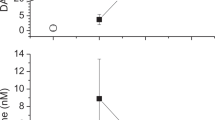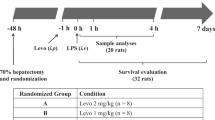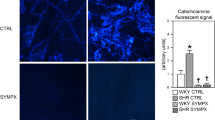Abstract
IT has been reported from this laboratory that the extreme susceptibility of adrenalectomized dogs to endotoxin is mainly a result of the development of an endogenous factor which produces marked hepatic engorgement of the shocked animals1,2. This factor seemed to be formed in the liver when its glycogen becomes depleted in the absence of glucocorticoids. The appearance of this factor in the circulating blood could be detected by injecting the shock serum into a normal recipient dog under pentobarbitone sodium anaesthesia when a delayed depressor response caused by induction of hepatic engorgement could be observed. This “shock-factor” in the serum was found to be non-dialysable, heat-unstable (inactivated by heating at 56° C for 30 min) and contained in the serum protein fraction precipitable by 20 per cent to 34 per cent saturation with ammonium sulphate. Further experiments, shortly to be published, showed that there was no appreciable release of histamine from the liver of endotoxin-shocked adrenalectomized dogs and that the “shock-factor” does not act as a histamine-releaser. The “shock-factor” and the hepatic engorgement were examined, therefore, in relation to an induction of histamine formation in the liver. Dogs are known to have no detectable histamine forming capacity in their tissues3, and so the possibility that histamine forming activity was induced in the liver of endotoxin-shocked adrenalectomized dogs was therefore examined, using the method of Waton3 to determine this capacity.
This is a preview of subscription content, access via your institution
Access options
Subscribe to this journal
Receive 51 print issues and online access
$199.00 per year
only $3.90 per issue
Buy this article
- Purchase on Springer Link
- Instant access to full article PDF
Prices may be subject to local taxes which are calculated during checkout
Similar content being viewed by others
References
Fukuda, T., Kobayashi, T., and Okada, M., Nature, 204, 585 (1964).
Fukuda, T., Okada, M., and Kobayashi, T., Jap. J. Physiol., 14, 560 (1964).
Waton, N. G., Brit. J. Pharmacol., 11, 119 (1956).
Weissbach, H., Lovenberg, W., and Udenfriend, S., Biochim. Biophys. Acta, 50, 177 (1961).
Weil, M. H., and Spink, W. W., J. Lab. Clin. Med., 50, 501 (1957).
Hinshaw, L. B., Vick, J. A., Carlson, C. H., and Fan, Y. L., Proc. Soc. Exp. Biol., 104, 379 (1960).
Author information
Authors and Affiliations
Rights and permissions
About this article
Cite this article
FUKUDA, T. Induction of Histamine Forming Capacity in Canine Liver by Endotoxin. Nature 214, 107–108 (1967). https://doi.org/10.1038/214107a0
Issue Date:
DOI: https://doi.org/10.1038/214107a0
Comments
By submitting a comment you agree to abide by our Terms and Community Guidelines. If you find something abusive or that does not comply with our terms or guidelines please flag it as inappropriate.



